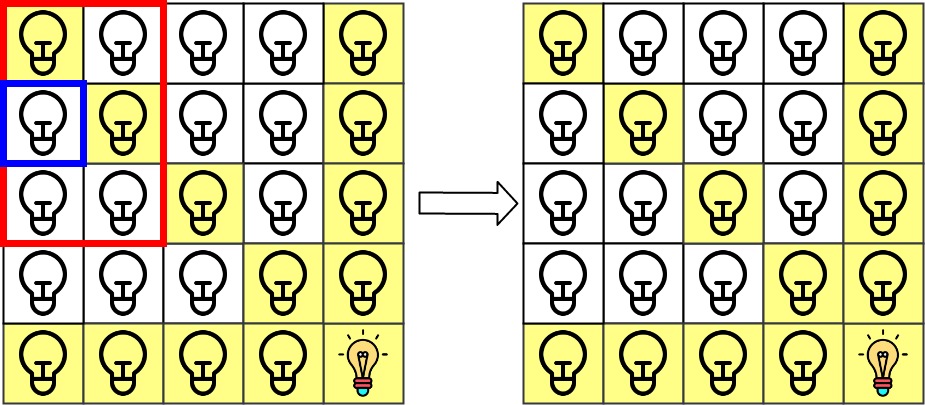There is a 2D grid of size n x n where each cell of this grid has a lamp that is initially turned off.
You are given a 2D array of lamp positions lamps, where lamps[i] = [rowi, coli] indicates that the lamp at grid[rowi][coli] is turned on. Even if the same lamp is listed more than once, it is turned on.
When a lamp is turned on, it illuminates its cell and all other cells in the same row, column, or diagonal.
You are also given another 2D array queries, where queries[j] = [rowj, colj]. For the jth query, determine whether grid[rowj][colj] is illuminated or not. After answering the jth query, turn off the lamp at grid[rowj][colj] and its 8 adjacent lamps if they exist. A lamp is adjacent if its cell shares either a side or corner with grid[rowj][colj].
Return an array of integersans, whereans[j]should be1if the cell in thejthquery was illuminated, or0if the lamp was not.
Input: n = 5, lamps = [[0,0],[4,4]], queries = [[1,1],[1,0]] Output: [1,0] Explanation: We have the initial grid with all lamps turned off. In the above picture we see the grid after turning on the lamp at grid[0][0] then turning on the lamp at grid[4][4]. The 0th query asks if the lamp at grid[1][1] is illuminated or not (the blue square). It is illuminated, so set ans[0] = 1. Then, we turn off all lamps in the red square.The 1st query asks if the lamp at grid[1][0] is illuminated or not (the blue square). It is not illuminated, so set ans[1] = 0. Then, we turn off all lamps in the red rectangle.
Input: n = 5, lamps = [[0,0],[4,4]], queries = [[1,1],[1,1]] Output: [1,1]
Input: n = 5, lamps = [[0,0],[0,4]], queries = [[0,4],[0,1],[1,4]] Output: [1,1,0]
1 <= n <= 1090 <= lamps.length <= 200000 <= queries.length <= 20000lamps[i].length == 20 <= rowi, coli < nqueries[j].length == 20 <= rowj, colj < n
use std::collections::HashMap;implSolution{pubfngrid_illumination(n:i32,lamps:Vec<Vec<i32>>,queries:Vec<Vec<i32>>) -> Vec<i32>{letmut on_lamps = HashMap::new();letmut illuminated_rows = HashMap::new();letmut illuminated_cols = HashMap::new();letmut illuminated_dias0 = HashMap::new();letmut illuminated_dias1 = HashMap::new();letmut ans = vec![0; queries.len()];for lamp in&lamps {let row = lamp[0];let col = lamp[1];let dia0 = row - col;let dia1 = row + col;if on_lamps.insert((row, col),(dia0, dia1)).is_none(){ illuminated_rows .entry(row).and_modify(|c| *c += 1).or_insert(1); illuminated_cols .entry(col).and_modify(|c| *c += 1).or_insert(1); illuminated_dias0 .entry(dia0).and_modify(|c| *c += 1).or_insert(1); illuminated_dias1 .entry(dia1).and_modify(|c| *c += 1).or_insert(1);}}for i in0..queries.len(){let row = queries[i][0];let col = queries[i][1];let dia0 = row - col;let dia1 = row + col; ans[i] = (*illuminated_rows.get(&row).unwrap_or(&0) > 0 || *illuminated_cols.get(&col).unwrap_or(&0) > 0 || *illuminated_dias0.get(&dia0).unwrap_or(&0) > 0 || *illuminated_dias1.get(&dia1).unwrap_or(&0) > 0)asi32;for x in -1..2{for y in -1..2{ifletSome((dia0, dia1)) = on_lamps.remove(&(row + x, col + y)){*illuminated_rows.get_mut(&(row + x)).unwrap() -= 1;*illuminated_cols.get_mut(&(col + y)).unwrap() -= 1;*illuminated_dias0.get_mut(&dia0).unwrap() -= 1;*illuminated_dias1.get_mut(&dia1).unwrap() -= 1;}}}} ans }}
